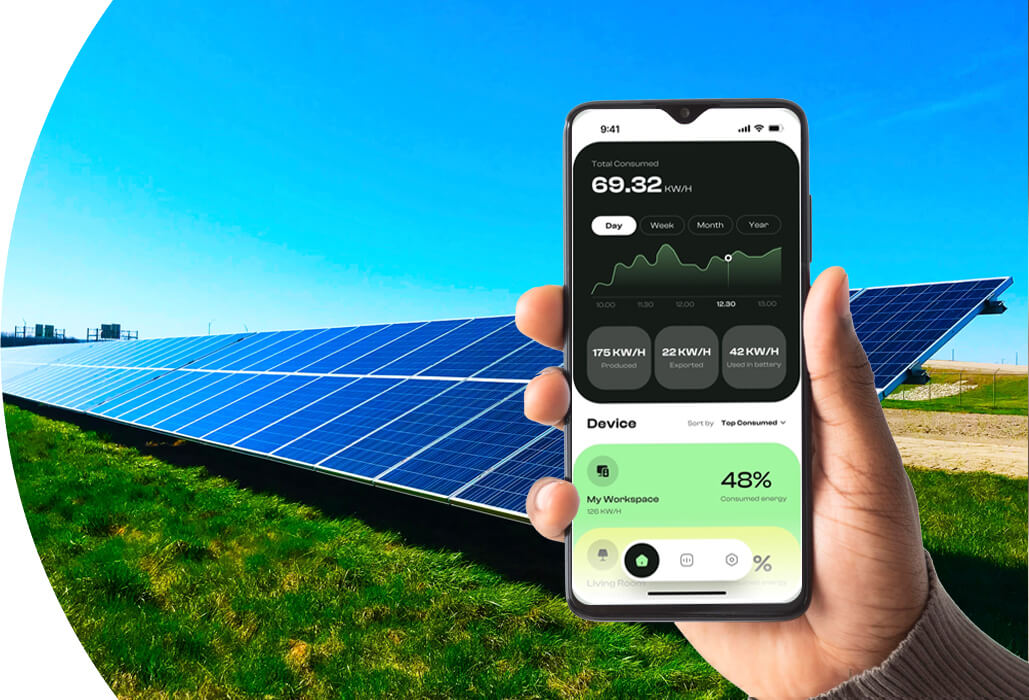
Benefits of Building a Solar Panel Monitoring App
By Udit Agarwal

The adoption of solar energy is rapidly increasing as individuals and businesses seek sustainable and cost-effective power solutions. However, managing and optimizing solar panel performance requires constant monitoring. A solar panel monitoring app seamlessly tracks and manages energy production, consumption, and system efficiency. Below, we explore the benefits of developing such an app and how it empowers solar energy users.
1. Real-Time Performance Monitoring
A solar panel monitoring app gives users real-time performance data on their solar system. Key metrics such as energy output, system efficiency, and environmental conditions can be tracked directly on a smartphone or tablet.
- Benefit: Users can immediately identify underperforming panels or system errors, reducing downtime and maximizing energy output.
- Example: An app alerting users about a sudden drop in energy production due to shading or technical issues enables timely maintenance.
2. Enhanced Energy Efficiency
Monitoring apps help users analyze energy production and consumption patterns. By providing insights into peak production hours and usage trends, these apps enable users to optimize their energy usage.
- Benefit: This promotes more intelligent energy use, such as scheduling energy-intensive tasks during peak production periods, ultimately reducing dependency on grid electricity.
- Example: Users can schedule appliance usage, like running washing machines or charging electric vehicles, during peak solar output to minimize energy costs.
3. Remote System Management
Solar panel monitoring apps allow users to manage their systems remotely. Whether it’s adjusting system settings, checking battery status, or monitoring inverter performance, users have complete control at their fingertips.
- Benefit: This is particularly valuable for users with systems installed in remote or hard-to-reach locations, as it eliminates the need for frequent on-site visits.
- Example: A farmer with a solar-powered irrigation system can monitor and adjust operations remotely, ensuring efficient water usage without visiting the site.
4. Cost Savings
A monitoring app significantly reduces operational costs by identifying inefficiencies, tracking energy savings, and enabling preventative maintenance.
- Benefit: The app helps users make informed energy usage and system maintenance decisions, translating into long-term financial savings.
- Example: Notifications about dirt accumulation on panels allow users to schedule cleaning promptly, improving energy output and avoiding loss of efficiency.
5. Environmental Impact Tracking
Many solar monitoring apps include features to track the environmental benefits of using solar energy, such as the amount of CO2 emissions avoided or the equivalent number of trees saved.
- Benefit: This feature motivates users by quantifying their contribution to sustainability and promoting further adoption of renewable energy.
- Example: Displaying a metric like “You have saved 1,000 kg of CO2 this year” strengthens the user’s commitment to solar energy.
6. System Diagnostics and Predictive Maintenance
Advanced solar panel monitoring apps have diagnostic tools that detect anomalies and predict potential system failures.
- Benefit: Proactive maintenance reduces repair costs, extends the lifespan of solar systems, and minimizes energy downtime.
- Example: Identifying an inverter malfunction early through the app allows users to schedule repairs before the issue escalates.
7. User-Friendly Interfaces for Data Insights
Modern solar panel monitoring apps feature intuitive dashboards that simplify complex data. Visual tools like graphs, charts, and detailed reports help users understand system performance.
- Benefit: Users of all technical backgrounds can quickly interpret data and take necessary actions to optimize performance.
- Example: A residential user can view a monthly report comparing energy production and consumption trends in an easily digestible format.
Also Read: What is Data Integration, and Why Does It Matter?
8. Integration with Smart Home and IoT Devices
Many solar monitoring apps integrate seamlessly with smart home systems and IoT devices, enhancing the user experience by creating a cohesive energy management ecosystem.
- Benefit: Users can automate processes, like turning off devices during low production periods, ensuring optimal energy use.
- Example: Connecting the app with a smart thermostat enables automatic adjustments based on available solar power, reducing energy wastage.
9. Customization and Scalability
Monitoring apps can be tailored to individual needs, catering to residential users, commercial businesses, or large-scale solar farms.
- Benefit: The app grows with the user’s needs, from monitoring a single system to managing multiple solar installations.
- Example: A business managing several solar installations across locations can track performance and generate system-wide reports from a single dashboard.
10. Increased User Engagement and Satisfaction
A solar panel monitoring app fosters user engagement by providing interactive features and gamified insights, such as achievements for reaching energy-saving goals.
- Benefit: Engaged users are likelier to maintain their systems effectively and recommend solar solutions to others.
- Example: Rewarding users with badges to reduce grid dependency creates a sense of achievement and enhances user satisfaction.
Conclusion
Building a solar panel monitoring app offers numerous benefits, including improved energy efficiency, cost savings, and enhanced system reliability. By providing real-time insights, remote management capabilities, and actionable data, these apps empower users to maximize the potential of their solar energy systems.
As solar adoption continues to rise, integrating advanced monitoring technology is essential for staying competitive and meeting the evolving demands of energy-conscious consumers. Investing in a solar panel monitoring app is not just a technological upgrade; it’s a step towards a sustainable future.